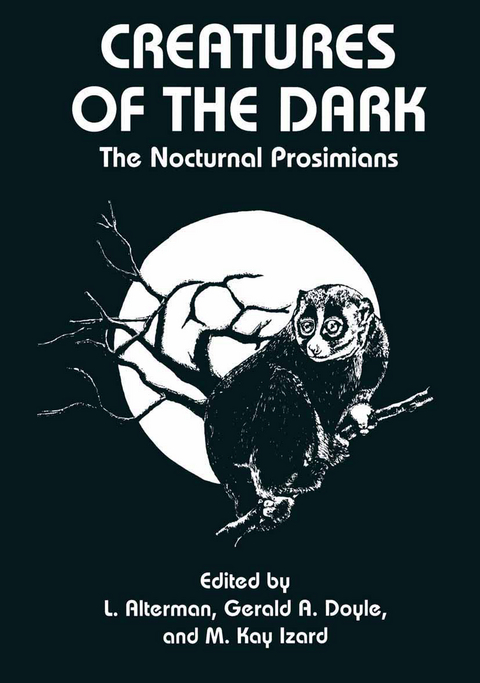
Creatures of the Dark
Springer-Verlag New York Inc.
978-1-4419-3250-1 (ISBN)
The papers in this volume are representative of those presented at a conference entitled "Creatures of the Dark: The Nocturnal Prosimians," held at Duke University, June 9-12, 1993. The purpose of the conference, attended by more than 100 scientists, was to assemble, for the ftrst time ever, scholars from diverse ftelds with a common interest in the nocturnal prosimian primates. The history of the precursors of this meeting are outlined in the Historical Perspective by Doyle (this volume). Most of the invited papers are presented here in modified form, as are several papers originally presented as posters. Two papers are included that were not presented, due to scheduling conftcts and health considerations. Some papers, delivered from the podium, are not included in this volume. Interactions among conference participants resulted in many revisions to the contributions, as did the comments of reviewers and the editors. Several papers which contained new data or new interpretations of familiar phenomena met with constructive criticism, resulting in modification of the original papers. We thank all of the contributors for their patience and cooperation, and commend the numerous reviewers who generously donated their time and expertise. We greatly appreciate funding from the National Institutes of Health, the Wenner Gren Foundation for Anthropological Research, the Duke University Center for International Studies, the Duke University Primate Center, and Drs. Charles Putman of Duke University and Malcolm Gillis, currently of Rice Universtiy.
Origins.- How Primates Invented the Rainforest and Vice Versa.- “Visual Predation,” Habitat Structure, and the Ancestral Primate Niche.- Pattern and Process in Strepsirhine Phylogeny.- Life History.- Predation, Pollination and Torpor in Two Nocturnal Prosimians: Cheirogaleus major and Microcebus rufus in the Rainforest of Madagascar.- Determinants of Nighttime Activity in “Diurnal” Lemurid Primates.- Life History Variation among Nocturnal Prosimians.- Sexual Selection and the Evolution of Copulatory Behavior in Nocturnal Prosimians.- The Bioenergetics of Reproduction in Prosimian Primates: Is It Related to Female Dominance?.- History, Anatomy, Subfossil Record and Management of Daubentonia madagascariensis.- Taxonomy and Phylogeny.- Phylogenetic Relations among Prosimii with Special Reference to Lemuriformes and Malagasy Nocturnals.- Phylogenetic Studies of Glutathione-Metabolizing Enzymes in Primate Lenses.- Species Diversity in Lorisids: A Preliminary Analysis of Arcticebus, Perodicticus, and Nycticebus.- The Subspecies of Loris tardigradus and Their Conservation Status: A Review.- Fluorescence in Situ Hybridization Reveals Homologies among Tarsier, Galago and Human Karyotypes.- Captive Behavior.- Behavior of Captive Loris tardigradus nordicus: A Qualitative Description, Including Some Information about Morphological Bases of Behavior.- Perspectives on Percussive Foraging in the Aye-Aye (Daubentonia madagascariensis).- Right Hand Preference and Performance Biases in the Foraging Behavior of the Aye-Aye.- Laterality in African and Malagasy Prosimians.- Vocal and Chemical Communication.- Acoustic Communication in Nocturnal Prosimians.- Species Diversity among Galagos with Special Reference to Mate Recognition.- Vocalizations of Some Cheirogaleid ProsimiansEvaluated in a Phylogenetic Context.- Chemocommunication in the Reproductive Function of Mouse Lemurs.- The Accessory (Vomeronasal) Chemoreceptor System in Some Prosimians.- Toxins and Toothcombs: Potential Allospecific Chemical Defenses in Nycticebus and Perodicticus.- Social Organization.- Social Organization and Food Constraints.- Social Organization in the Aye-Aye (Daubentonia madagascariensis) and the Perceived Distinctiveness of Nocturnal Primates.- Locomotion.- Locomotion in Nocturnal Prosimians.- Functional Morphology of Leaping Behaviors in Galagids: Associations between Landing Limb Use and Diaphyseal Geometry.- Locomotor Adaptations of Eocene Primates: Adaptive Diversity among the Earliest Prosimians.- Conservation.- Captive Conservation and the Role of the AZA Prosimian Advisory Group.- The Role of Studbooks in Conservation and Captive Management of Nocturnal Prosimians.- The Madagascar Fauna Group.- Aye-Aye Conservation: The Role of the Jersey Wildlife Preservation Trust.- The Nocturnal Prosimian Colony at the Duke University Primate Center.- A New Role for the Military: Environmental Protection and Restoration.- Afterword.- Prosimians: From Obscurity to Extinction?.
| Erscheint lt. Verlag | 1.12.2010 |
|---|---|
| Zusatzinfo | IX, 571 p. |
| Verlagsort | New York, NY |
| Sprache | englisch |
| Maße | 178 x 254 mm |
| Themenwelt | Naturwissenschaften ► Biologie ► Evolution |
| Naturwissenschaften ► Biologie ► Zoologie | |
| ISBN-10 | 1-4419-3250-X / 144193250X |
| ISBN-13 | 978-1-4419-3250-1 / 9781441932501 |
| Zustand | Neuware |
| Haben Sie eine Frage zum Produkt? |
aus dem Bereich


